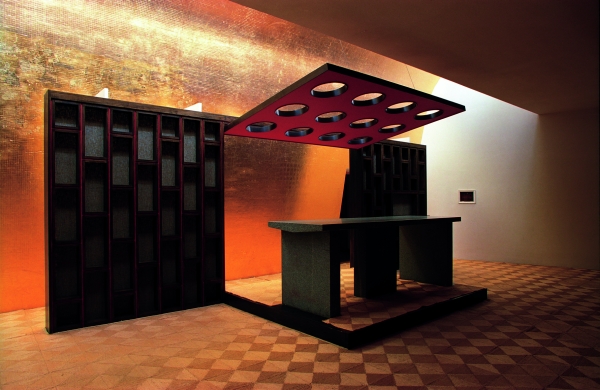Marcel Breuer – Design and Architecture
Vienna, Hofmobiliendepot, 16. 03. – 06. 11. 2011.

St. Benedek kápolna szentélye, St. John College, USA
Developed by the Vitra Design Museum, this retrospective of Marcel Breuer’s work is the first exhibition to pay tribute to Breuer’s achievements as an architect as well as a designer. The Vienna version of the exhibition includes four scale models of his single-family houses.
Marcel Breuer – the designer
In the section entitled ‘Materials’ the exhibition documents Breuer’s design oeuvre chronologically, taking its cue from his sequential use of four different materials: solid wood, tubular steel, aluminium and laminated bentwood. Numerous original pieces of his tubular steel furniture demonstrate how swiftly he grasped the structural and design potential of a material, exploring it almost systematically within the space of only a few years. The salient feature of Breuer’s work with aluminium, a material that had hitherto hardly been used in furniture-making, was the transfer of the cantilever principle he had perfected for tubular steel. Another masterly achievement was the replication of his aluminium recliner in the medium of plywood, marking the beginning of an intensive preoccupation with this material. In addition to the furniture exhibits, a selection of drawings, furniture catalogues and numerous contemporary photographs of Breuer’s interior designs convey the wide range and variety of his work as a designer.
Marcel Breuer – the architect
At the exhibition in the Hofmobiliendepot Breuer’s architectural oeuvre will be explored through models of four single-family houses: the Breuer I House in Lincoln, Massachusetts (1938/39); the Robinson House in Williamstown, Massachusetts (1946–48); the Breuer II House in New Canaan, Connecticut (1947/48) and the Villa Staehelin in Feldmeilen near Zurich, Switzerland (1956-59). The exhibition also includes models of Marcel Breuer’s spectacular religious buildings: St John’s Abbey in Collegeville, Minnesota, the St Francis de Sales church in Muskegon, Michigan, the Annunciation Priory of the Sisters of St Benedict, Bismarck, North Dakota and Baldegg Convent in Switzerland.
Motifs and textures
Entitled Motifs, the last section of the exhibition presents central elements of Breuer’s design vocabulary which can be construed as linking the different areas of his creative activity. Thus the motif of the cantilever, already found in his early furniture designs, was reinterpreted in ever new ways in many of his buildings in the decades that followed. The same is true of the horizontal bands and rectangles – striking design elements that give many of his furniture pieces, interiors and buildings their characteristic appearance. Breuer’s manifest interest in textures can likewise be read as forming a link between design and architecture, whereas the almost Cubist feel of the crystalline language of forms that distinguishes many of his concrete buildings did not emerge until the 1950s. From that time on it can be regarded as the hallmark of his personal approach to this central material of twentieth-century architecture. Marcel Breuer died in New York on 1 July 1981. Marking the thirtieth anniversary of his death, this exhibition provides an ideal opportunity of exploring his oeuvre and his place in the history of design and architecture. Marcel Breuer’s furniture designs are still commercially available today. His designs are produced by Knoll (including the Wassily club chair), Tecta (B40, D40) and Thonet (S285, B22, B10, B9, S35, S32/S64).





